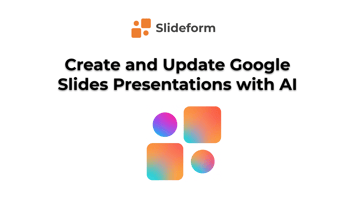Looker Studio, formerly Google Data Studio, is a low-cost, easy-to-use business analytics solution....
Getting Started with Slideform
What is Slideform?
Slideform is an AI-enabled automation platform that links data from BI dashboards to reports, slides, and documents. You use your own template, and Slideform fills in the data. You can even create customized charts and text insights for your reports with Slideform AI.
Read on for all the details, or watch the video demo.
Getting Started

1. The data source

To add a new data source, go to Data Sources > Add Data Source. There you will see a card for each supported data source. Click Add Integration to get started. For help, see How to Connect a Data Source.
2. The slide deck template
The template is a repeatable presentation with placeholders for content to be pulled in from data sources. The template specifies the layout of content, the colors, formatting, and styling of the presentation results.


From the Configure page you can also set the associated data sources, output settings, schedule, team access, and other settings. Find all the details here: Project Settings.
3. Match data to the template

Find out how to set up pragmas here: Configure the data mapping
4. Generate the presentation
Once the pragmas are matched to data, we can create the presentation results. Click Generate on the project card.
A preview of the slides will appear on the next screen. If the preview looks good, click Get Final Results to save the output as a Powerpoint file or Google Slides. The results will then be listed on the home page under Results.
Here's some output for our example.

Additional Capabilities:
You can specify a filename for the output, set email notifications, disable previews, and more in the Project Settings. For details, visit Project Settings.
To set a schedule to generate the slides, go to Schedule at the top of the Configure screen. For details see, How to set a schedule for recurring presentations.
Have questions? We're here to help. Contact support@slideform.co for help setting up your automation.



